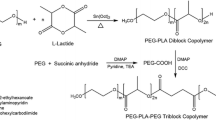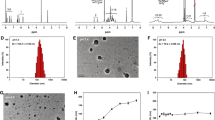Abstract
Chemotherapy is a traditional therapeutic approach for the treatment of many solid tumors, but the poor solubility and low bioavailability of hydrophobic anti-cancer drugs greatly limit their applications. In this article, DOX-loaded micelles were fabricated based on an amphiphilic graft polymer composed of hydrophilic poly(γ-glutamic acid) (γ-PGA) and hydrophobic poly (l-lactide) (PLLA). The structure of the copolymers and the characteristic of the micelles were studied. The release profiles of doxorubicin as a model drug from the micelles were measured. Due to the protonation of the amino group of DOX and the conformational alteration of γ-PGA, the release of DOX from γ-PGA-g-PLLA micelle was faster in the acid condition, which is beneficial to tumor therapy. The cellular uptake of the DOX-loaded γ-PGA-g-PLLA micelle was proved to be a GGT-mediated process.







Similar content being viewed by others
References
Peer D, Karp JM, Hong S, et al. Nanocarriers as an emerging platform for cancer therapy. Nat Nanotechnol. 2007;2:751–60.
Matsumura Y, Maeda H. A new concept for macromolecular therapeutics in cancer chemotherapy: mechanism of tumoritropic accumulation of proteins and the antitumor agent smancs. Cancer Res. 1986;46:6387–92.
Zhong Y, Meng F, Deng C, et al. Ligand-directed active tumor-targeting polymeric nanoparticles for cancer chemotherapy. Biomacromolecules. 2014;15:1955–69.
Wang X, Li S, Shi Y, et al. The development of site-specific drug delivery nanocarriers based on receptor mediation. J Control Release. 2014;193:139–53.
Barouki R, Finidori J, Chobert M, et al. Biosynthesis and processing of gamma-glutamyl transpeptidase in hepatoma tissue culture cells. J Biol Chem. 1984;259:7970–4.
Pompella A, De Tata V, Paolicchi A, et al. Expression of γ-glutamyl transferase in cancer cells and its significance in drug resistance. Biochem Pharmacol. 2006;71:231–8.
Yao D, Jiang D, Huang Z, et al. Abnormal expression of hepatoma specific γ-glutamyl transferase and alteration of γ-glutamyl transferase gene methylation status in patients with hepatocellular carcinoma. Cancer. 2000;88:761–9.
Liao ZX, Peng SF, Ho YC, et al. Mechanistic study of transfection of chitosan/DNA complexes coated by anionic poly (γ-glutamic acid). Biomaterials. 2012;33:3306–15.
Peng SF, Tseng MT, Ho YC, et al. Mechanisms of cellular uptake and intracellular trafficking with chitosan/DNA/poly (γ-glutamic acid) complexes as a gene delivery vector. Biomaterials. 2011;32:239–48.
Peng SF, Yang MJ, Su CJ, et al. Effects of incorporation of poly (γ-glutamic acid) in chitosan/DNA complex nanoparticles on cellular uptake and transfection efficiency. Biomaterials. 2009;30:1797–808.
Kurosaki T, Kitahara T, Fumoto S, et al. Ternary complexes of pDNA, polyethylenimine, and γ-polyglutamic acid for gene delivery systems. Biomaterials. 2009;30:2846–53.
Chang KY, Cheng LW, Ho GH, et al. Fabrication and characterization of poly(γ-glutamic acid)-graft-chondroitin sulfate/polycaprolactone porous scaffolds for cartilage tissue engineering. Acta Biomater. 2009;5:1937–47.
Zeng Wen HuWK, Hao Li, et al. Preparation and characterization of poly (γ-glutamic acid) hydrogels as potential tissue engineering scaffolds. Chin J Polym Sci. 2014;32:1507–14.
Wang X, Uto T, Akagi T, et al. Poly (γ-glutamic acid) nanoparticles as an efficient antigen delivery and adjuvant system: potential for an aids vaccine. J Med Virol. 2008;80:11–9.
Mi FL, Wu YY, Lin YH, et al. Oral delivery of peptide drugs using nanoparticles self-assembled by poly (γ-glutamic acid) and a chitosan derivative functionalized by trimethylation. Bioconjug Chem. 2008;19:1248–55.
Akao T, Kimura T, Hirofuji Y, et al. A poly (γ-glutamic acid)-amphiphile complex as a novel nanovehicle for drug delivery system. J Drug Target. 2010;18:550–6.
Shen HY, Akagi T, Akashi M. Polyampholyte nanoparticles prepared by self-complexation of cationized poly (γ-glutamic acid) for protein carriers. Macromol Biosci. 2012;12:1100–5.
Shima F, Shudo M, Akagi T, et al. Preparation of siRNA carrier based on boronic acid functionalized amphiphilic poly (γ-glutamic acid) nanoparticles. Chem Lett. 2014;43:840–2.
Zhu Y, Akagi T, Akashi M. Preparation and characterization of nanoparticles formed through stereocomplexation between enantiomeric poly (γ-glutamic acid)-graft-poly (lactide) copolymers. Polym J. 2013;45:560–6.
Han L, Hiratake J, Kamiyama A, et al. Design, synthesis, and evaluation of γ-phosphono diester analogues of glutamate as highly potent inhibitors and active site probes of γ-glutamyl transpeptidase. Biochemistry. 2007;46:1432–47.
Ouchi T, Uchida T, Arimura H, et al. Synthesis of poly (l-lactide) end-capped with lactose residue. Biomacromolecules. 2003;4:477–80.
Zhao CL, Winnik MA, Riess G, et al. Fluorescence probe techniques used to study micelle formation in water-soluble block copolymers. Langmuir. 1990;6:514–6.
Moyano DF, Saha K, Prakash G, et al. Fabrication of corona-free nanoparticles with tunable hydrophobicity. ACS Nano. 2014;8:6748–55.
Sun Y, Zou W, Bian S, et al. Bioreducible PAA-g-PEG graft micelles with high doxorubicin loading for targeted antitumor effect against mouse breast carcinoma. Biomaterials. 2013;34:6818–28.
Maeda H, Matsumura Y. Tumoritropic and lymphotropic principles of macromolecular drugs. Crit Rev Ther Drug Carrier Syst. 1988;6:193–210.
Righetti PG, Menozzi M, Gianazza E, et al. Protolytic equilibria of doxorubicin as determined by isoelectric focusing and ‘electrophoretic titration curves’. FEBS Lett. 1979;101:51–5.
Checot F, Lecommandoux S, Gnanou Y, et al. Water-soluble stimuli-responsive vesicles from peptide-based diblock copolymers. Angew Chem Int Ed. 2002;41:1339–43.
Ho GH, Ho TI, Hsieh KH, et al. γ-Polyglutamic acid produced by Bacillus subtilis (natto): structural characteristics, chemical properties and biological functionalities. J Chin Chem Soc. 2006;53:1363–84.
Acknowledgments
This work was financially supported by the National Natural Science Foundation of China (Grant Nos. 51373130, 21004080), the Program for New Century Excellent Talents in Universities (Grant No. NCET-09-0818) of the Ministry of Education of China, the Science and Technology Planning Project of Guangdong Province (Grant No. 2011A060901013), the Guangdong Innovative Research Team Program (Grant No. 2009010057), and the Program for Industry, University & Research Institute Collaboration of Guangdong Province (Grant No. 2012B091100452).
Author information
Authors and Affiliations
Corresponding authors
Electronic supplementary material
Below is the link to the electronic supplementary material.
Rights and permissions
About this article
Cite this article
Liu, M., Huang, G., Cong, Y. et al. The preparation and characterization of micelles from poly(γ-glutamic acid)-graft-poly(l-lactide) and the cellular uptake thereof. J Mater Sci: Mater Med 26, 187 (2015). https://doi.org/10.1007/s10856-015-5519-y
Received:
Accepted:
Published:
DOI: https://doi.org/10.1007/s10856-015-5519-y




